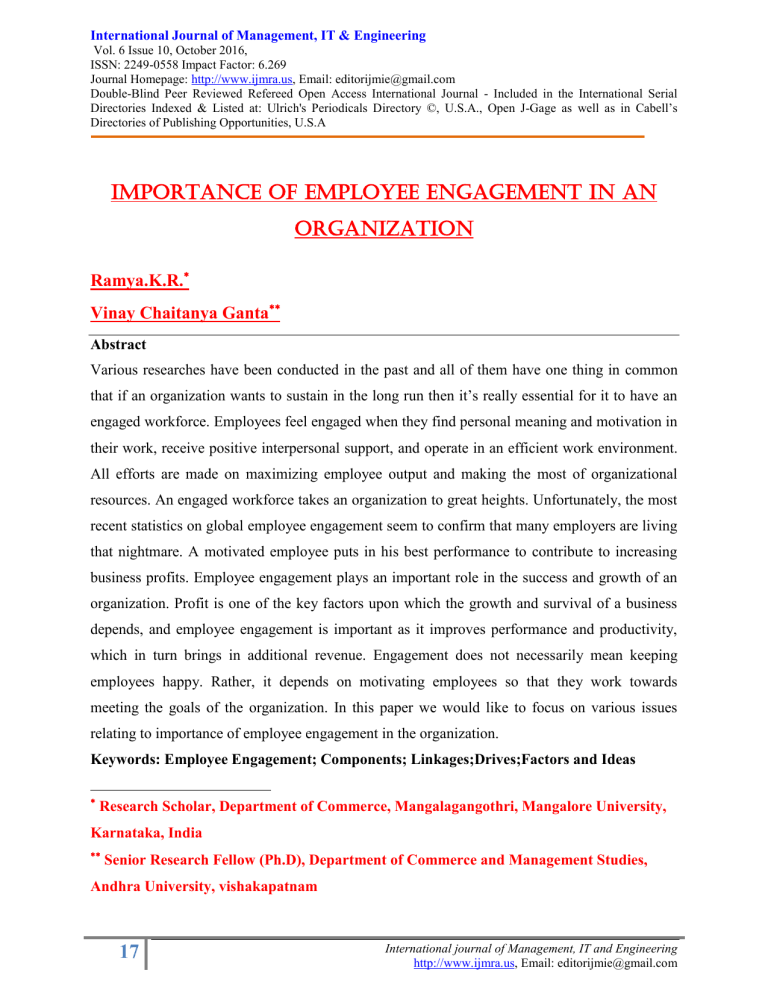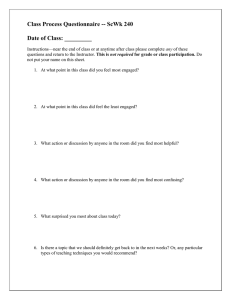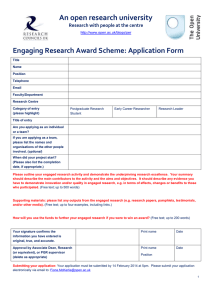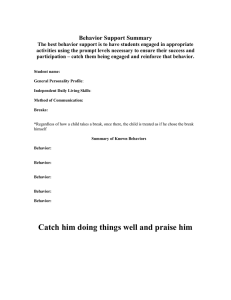IJMRA-10484
advertisement

International Journal of Management, IT & Engineering Vol. 6 Issue 10, October 2016, ISSN: 2249-0558 Impact Factor: 6.269 Journal Homepage: http://www.ijmra.us, Email: editorijmie@gmail.com Double-Blind Peer Reviewed Refereed Open Access International Journal - Included in the International Serial Directories Indexed & Listed at: Ulrich's Periodicals Directory ©, U.S.A., Open J-Gage as well as in Cabell’s Directories of Publishing Opportunities, U.S.A IMPORTANCE OF EMPLOYEE ENGAGEMENT IN AN ORGANIZATION Ramya.K.R. Vinay Chaitanya Ganta Abstract Various researches have been conducted in the past and all of them have one thing in common that if an organization wants to sustain in the long run then it’s really essential for it to have an engaged workforce. Employees feel engaged when they find personal meaning and motivation in their work, receive positive interpersonal support, and operate in an efficient work environment. All efforts are made on maximizing employee output and making the most of organizational resources. An engaged workforce takes an organization to great heights. Unfortunately, the most recent statistics on global employee engagement seem to confirm that many employers are living that nightmare. A motivated employee puts in his best performance to contribute to increasing business profits. Employee engagement plays an important role in the success and growth of an organization. Profit is one of the key factors upon which the growth and survival of a business depends, and employee engagement is important as it improves performance and productivity, which in turn brings in additional revenue. Engagement does not necessarily mean keeping employees happy. Rather, it depends on motivating employees so that they work towards meeting the goals of the organization. In this paper we would like to focus on various issues relating to importance of employee engagement in the organization. Keywords: Employee Engagement; Components; Linkages;Drives;Factors and Ideas Research Scholar, Department of Commerce, Mangalagangothri, Mangalore University, Karnataka, India Senior Research Fellow (Ph.D), Department of Commerce and Management Studies, Andhra University, vishakapatnam 17 International journal of Management, IT and Engineering http://www.ijmra.us, Email: editorijmie@gmail.com ISSN: 2249-0558 Impact Factor: 6.269 1. Introduction Employee Engagement is a property of the relationship between an organization and its employees. An "engaged employee" is one who is fully absorbed by and enthusiastic about their work and so takes positive action to further the organization's reputation and interests. Employee engagement is a workplace approach resulting in the right conditions for all members of an organisation to give of their best each day, committed to their organisation’s goals and values, motivated to contribute to organisational success, with an enhanced sense of their own wellbeing. An organization with 'high' employee engagement might therefore be expected to outperform those with 'low' employee engagement, all else being equal. There are, however, a range of definitions that have emerged around concepts relating to employee engagement. Research has looked at the involvement, commitment and productivity of employees. Organizations have often had a focus on how to generate engagement, rather than seeking objective ways to measure it. Care must therefore be taken when looking at some of the statistics presented around engagement. 2. Review of Literature Managers agree that modern business demands higher productivity and more efficiency, than in previous times. Companies are trying to increase their performance in order to place their company ahead of the competitors. At some point, satisfied employees, content with their work experience, was a good formula for success, as a satisfied employee, who wanted to stay with a company, contributed to the workforce stability and productivity (Sanchez and McCauley, 2006). But those times have changed. Nowadays, the business environment is global and competitive and simply satisfied and stable employees are not enough to bring necessary business results. Satisfied employees may just meet the work demands, but this will not lead to higher performance (Abraham, 2012). In order to compete effectively, employers need to go beyond satisfaction - employers must do their best to inspire their employees to apply their full potential and capabilities to their work, if they do not, part of the valuable employees’ resources remains unavailable for the company (Bakker and Leiter, 2010). Therefore, modern organizations expect their employees to be full of enthusiasm and show initiative at work, they want them to take 18 International journal of Management, IT and Engineering http://www.ijmra.us, Email: editorijmie@gmail.com ISSN: 2249-0558 Impact Factor: 6.269 responsibility for their own development, strive for high quality and performance, be energetic and dedicated to what they do – in other words companies want their employees be engaged (Bakker and Leiter, 2010). Other researchers state that employee engagement is the best tool in the company’s efforts to gain competitive advantages and stay competitive (Rashid et al., 2011). Therefore, the construct of employee engagement has been an area of interest among many researchers and consultancy firms, and received its recognition in the management literature and among practitioners (Ologbo and Saudah, 2011). 3. Components Of Employee Engagement There are two primary factors that drive employee engagement. These factors are based on statistical analysis and widely supported by industry research. Engagement with the Organization measures how engaged employees are with the organization as a whole, and by extension, how they feel about senior management. This factor has to do with confidence in organizational leadership as well as trust, fairness, values, and respect - i.e. how people like to be treated by others, both at work and outside of work. Engagement with “Manager" is a more specific measure of how employees feel about their direct supervisors. Topics include feeling valued, being treated fairly, receiving feedback and direction, and generally, having a strong working relationship between employee and manager based on mutual respect. Engagement Is Linked To Three Essential Forces In The Organization - Attrition, Productivity & Profitability. Attrition is the number of people leaving the organization and it's a well-known fact that is one of the major problem being faced by the organizations be it any sector. An engaged workforce definitely has less chances of leaving the organization, a person who is engaged in his work is likely to stick to the company as he offers his best and as result of which the organizations takes due care of him in the form of hike in salary by way of incentives and bonus. Attrition is likely to come down in the organization, which have engaged workforce and this will get in the likely benefits for the organization. Productivity is the output of the workers in the form of work done by them its not the quantity that matters it's the quality that is of importance for the organization. An engaged workforce has an understanding of what is expected of them at work so thus they are able to 19 International journal of Management, IT and Engineering http://www.ijmra.us, Email: editorijmie@gmail.com ISSN: 2249-0558 Impact Factor: 6.269 carry on their task effectively and efficiently thus adding to the productivity of the organization and thus adding to the growth and success of the organization. Profitability is the ability of a company to earn a profit. It is a relative measure of success for a business. Research has proved that an engaged workforce is likely to result in an increase in the profitability of the concern as they have complete dedication and commitment to their work and thus this is likely to result in an increase in the profit of the concern and thus ensuring the success of the organization. The organizations now days take all reasonable steps to ensure that they have engaged workforce like organizing birthday bashes, talent shows, sports activities and many other things. They want their employees to be committed to their work fully besides all the above activities they also make sure that the employees have role clarity, get all the material and equipment they require to perform their work efficiently etc. 4. Importance Of Employee Engagement In An Organization A motivated employee puts in his best performance to contribute to increasing business profits. Employee engagement plays an important role in the success and growth of an organization. Profit is one of the key factors upon which the growth and survival of a business depends, and employee engagement is important as it improves performance and productivity, which in turn brings in additional revenue. Engagement does not necessarily mean keeping employees happy. Rather, it depends on motivating employees so that they work towards meeting the goals of the organization. Employee engagement is a two way process. At the first level, the organization works towards keeping employees engaged by providing them with the right environment, challenges and incentives. In return, employees contribute through an increase in productivity and improved performance, which results in higher profits. The level of engagement of an employee depends on several factors. When these factors work in the right combination, employee engagement can be high. If not, it can be low and result in a situation where the employee starts looking for opportunities outside the organization. Thus, it is the responsibility of every manager to assess 20 International journal of Management, IT and Engineering http://www.ijmra.us, Email: editorijmie@gmail.com ISSN: 2249-0558 Impact Factor: 6.269 the level of engagement of every employee whom he supervises and find out what keeps him motivated. These are some of the important factors to keep in mind while determining the level of engagement of employees 4.1 Understanding their Role in the Company's Strategy While individual goals and targets help an employee understand what is expected of him, it might not keep him motivated for long unless he knows the importance of his role in helping the business achieve its goals. For instance, a customer service representatives job might involve recording and responding customer queries. He might meet expectations by responding to customer queries in a routine manner, but might get bored by the task after some time. If his manager explains to him the importance of his role in the profits of the company as a satisfied customer will recommend the company’s product or services, it will give the employee a sense of importance and encourage him to perform his job to the best of his ability with the goal of keeping the customer happy rather than just answering queries routinely. 4.2 Recognition Being recognized for their contribution to the organization is one of the main factors that lead to employee engagement. It is the manager’s responsibility to recognize or reward an employee for exceptional performance or achieving his targets. Lack of recognition will make the employee feel that his hard work is going to nothing, and it might make him look for another job where his skills and efforts are better appreciated. 4.3. Relationship with Manager Maintaining open communication with employees and gaining their trust is one of the best ways that a manager can keep his team engaged. Knowing that they can turn to him for guidance or support can help the employee feel secure in his work environment and lead to better performance and productivity. 21 International journal of Management, IT and Engineering http://www.ijmra.us, Email: editorijmie@gmail.com ISSN: 2249-0558 Impact Factor: 6.269 4.4Peer Culture A work culture that helps employees to thrive in the midst of their peers through friendly work relationships can install a sense of team spirit that contributes to employee engagement. An employee who feels comfortable working with his peers will be motivated to put in his best effort to earn their respect and recognition. 4.5. Fair Compensation Paying employees as per their performance and at rates that match industry standards is another way to keep them engaged. An employee who knows that he is being paid as well as if not better than his peers in the industry will be encouraged to continue to give his best performance. Within the organization, while pay scales might differ from one employee to another, having clear guidelines that link pay to performance through a transparent process can contribute towards making every employee feel that he is receiving fair treatment. 4.6. Opportunities For Development Providing employees opportunities that help them to grow in their career by either learning new skills or providing them with challenges is another way to keep employees engaged. Managers can present opportunities for employees to work with new teams or interact with experts within the organization for developing additional skills or acquiring knowledge about a field of interest. It is important for managers to understand what motivates a particular employee. Creating a work environment where an employee can achieve his potential without feeling dissatisfied about work relationships, lack of recognition or unfair treatment can help in keeping him engaged. 5. Drivers Of Engagement Some additional points from research into drivers of engagement are presented below: Employee perceptions of job importance:"An employee's attitude toward the job's importance and the company had the greatest impact on loyalty and customer service than all other employee factors combined. 22 International journal of Management, IT and Engineering http://www.ijmra.us, Email: editorijmie@gmail.com ISSN: 2249-0558 Impact Factor: 6.269 Employee clarity of job expectations: "If expectations are not clear and basic materials and equipment are not provided, negative emotions such as boredom or resentment may result, and the employee may then become focused on surviving more than thinking about how he can help the organization succeed." Career advancement / improvement opportunities: "Plant supervisors and managers indicated that many plant improvements were being made outside the suggestion system, where employees initiated changes in order to reap the bonuses generated by the subsequent cost savings." Regular feedback and dialogue with superiors: "Feedback is the key to giving employees a sense of where they’re going, but many organizations are remarkably bad at giving it." "'What I really wanted to hear was 'Thanks. You did a good job.' But all my boss did was hand me a check.'" Quality of working relationships with peers, superiors, and subordinates: "If employees' relationship with their managers is fractured, then no amount of perks will persuade the employees to perform at top levels. Employee engagement is a direct reflection of how employees feel about their relationship with the boss." Perceptions of the ethos and values of the organization: “Inspiration and values' is the most important of the six drivers in our Engaged Performance model. Inspirational leadership is the ultimate perk. It is unlikely to engage employees." Effective internal employee communications: “which convey a clear description of "what's going on.” Recent research has focused on developing a better understanding of how variables such as quality of work relationships and values of the organization interact, and their link to important work outcomes. From the perspective of the employee, "outcomes" range from strong commitment to the isolation of oneself from the organization. 6. Factors That Contribute To Engagement Out of these five factors that contribute to engagement, employees generally have one dominant need, determined by their individual personalities, goals, and past experiences. Belonging: One way the leaders can ensure employees are engaged is to ensure that they are thinking, “I belong here.” An employee who feels as though she is part of her workplace’s 23 International journal of Management, IT and Engineering http://www.ijmra.us, Email: editorijmie@gmail.com ISSN: 2249-0558 Impact Factor: 6.269 community and has an emotional connection to her organization will be more engaged at work. Ways to ensure that everyone on the team feels a sense of belonging include not holding meetings from which certain staffers are routinely excluded, and regularly soliciting ideas from everyone on the team, not just the select few “stars.” Enjoyment: For many employees, engagement means having a little fun at the office once in a while. Creating a positive work environment that includes fun ways for employees to interact will go a long way in engaging employees. Whether this means having an occasional birthday or holiday celebration in the office, or a more formal annual retreat, employees will have something to look forward to other than the (let’s face it, occasionally monotonous) daily grind. Alignment: It’s important for leaders to acknowledge that their team’s efforts are supporting a greater mission or purpose at work. Let employees know specifically how their work is aligned with the organization’s mission. Recognition: Another key component of engagement is employee recognition. Most employees want to be recognized by their managers for their hard work. Leaders who fail to implement reward systems do their employees and their companies a disservice. Whether it’s a sizable annual reward or some smaller form of recognition, such as a simple note of thanks, managers should not underestimate the importance of acknowledging employees’ successes. Advancement: Offering plenty of opportunities for employees to build their skills should be a priority for leaders looking to increase engagement. After all, talented employees do not want to stagnate professionally, they want to develop their skills, advance, and thrive. Companies can offer advancement opportunities in a variety of ways, from promotions to in-house training, to college-level courses that the company funds. 7. Ideas To Increase Employee Engagement Few ideas to enhance employee engagement are as follows; 1. Senior leadership must articulate a clear vision to all employees. Without a clear goal, employees will not know what they’re working toward. 24 International journal of Management, IT and Engineering http://www.ijmra.us, Email: editorijmie@gmail.com ISSN: 2249-0558 Impact Factor: 6.269 2. Employees should be encouraged to openly communicate and influence the company’s vision with their input. 3. Direct managers should foster healthy relationships with their employees. 4. Senior leadership should continuously demonstrate that employees have an impact on their work environment. 5. Managers should show employees that they are valued as true contributors, giving them a sense of empowerment. 6. Managers should organize and encourage team volunteerism in communities as a way of giving back and encouraging social interaction outside the office. 7. Companies should give back to local nonprofits. Corporate giving programs, like matching gift programs and volunteer grants, are a great way for corporations to support organizations that employees care about. References [1] Abraham, S., “Development of Employee Engagement Programme on the basis of Employee Satisfaction Survey”. Journal of Economic Development, Management, IT, Finance and Marketing, 4(1), pp. 27-37,2012 [2] Bakker, A.B. and Leiter M.P., “Work engagement: a handbook of essential theory and research.” New York, NY: Psychology Press, 2010 [3] http://engageforsuccess.org/what-is-employee-engagement [4] http://www.custominsight.com/employee-engagement-survey/what-is-employee- engagement.asp [5] http://www.huffingtonpost.com/entry/the-growing-importance- of_1_b_6775364.html?section=india [6] https://doublethedonation.com/blog/2015/09/the-importance-of-increasing-employee- engagement-using-corporate-giving-programs/ [7] https://en.wikipedia.org/wiki/Employee_engagement [8] https://www.linkedin.com/pulse/why-employee-engagement-so-important-madhu-nair [9] https://www.td.org/Publications/Magazines/TD/TD-Archive/2014/08/Webex-5-Most- Important-Employee-Engagement-Needs 25 International journal of Management, IT and Engineering http://www.ijmra.us, Email: editorijmie@gmail.com ISSN: 2249-0558 Impact Factor: 6.269 [10] https://www.td.org/Publications/Magazines/TD/TD-Archive/2014/08/Webex-5-Most- Important-Employee-Engagement-Needs Ologbo, C.A. and Saudah, S. “Engaging People who Drive Execution and Organizational [11] Performanc.” American Journal of Economics and Business Administration, 3(3), pp. 569-575, 2011 [12] Sanchez, P. and McCauley, D. “Measuring and Managing Engagement in a Cross cultural Workforce: New Insights for Global Companies.” Global Business and Organizational Excellence, 26(1), pp. 41 – 50,2006 26 International journal of Management, IT and Engineering http://www.ijmra.us, Email: editorijmie@gmail.com





